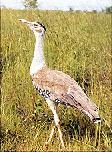By Dr. Susan Sharma
 Schedule I, Part III of the Indian Wildlife (Protection) Act, 1972 lists rare and endangered birds which are totally protected throughout the country, live or dead or part thereof. They include Andaman Teal, Assam Bamboo Partridge,
Bazas, Bengal Florican, Blacknecked Crane, Blood Pheasants, , Eastern White Stork, Forest spotted owlet, Jerdon's Courser, Cheer Pheasant, Great Pied Hornbill, Hawks, Hooded Crane, Hornbills, Houbara Bustard, Humes Bartailed Pheasant, Indian Pied Hornbill,
Lammergeier, Large Falcons, Large Whistling Teal, Monal pheasant, Mountain Quail, Narcondam Hornbill, Nicobar Megapode, Nicobar Pigeon, Osprey, Peacock-Pheasant, Peafowl or Indian Peafowl, Pinkheaded Duck, Scalter's Monal Pheasant, Siberian White Crane, Tibetan
Snowcock, Tragopan-Pheasant, Whitebellied Sea Eagle, White-eared Pheasant, White Spoonbill, and Whitewinged Wood Duck.
Schedule I, Part III of the Indian Wildlife (Protection) Act, 1972 lists rare and endangered birds which are totally protected throughout the country, live or dead or part thereof. They include Andaman Teal, Assam Bamboo Partridge,
Bazas, Bengal Florican, Blacknecked Crane, Blood Pheasants, , Eastern White Stork, Forest spotted owlet, Jerdon's Courser, Cheer Pheasant, Great Pied Hornbill, Hawks, Hooded Crane, Hornbills, Houbara Bustard, Humes Bartailed Pheasant, Indian Pied Hornbill,
Lammergeier, Large Falcons, Large Whistling Teal, Monal pheasant, Mountain Quail, Narcondam Hornbill, Nicobar Megapode, Nicobar Pigeon, Osprey, Peacock-Pheasant, Peafowl or Indian Peafowl, Pinkheaded Duck, Scalter's Monal Pheasant, Siberian White Crane, Tibetan
Snowcock, Tragopan-Pheasant, Whitebellied Sea Eagle, White-eared Pheasant, White Spoonbill, and Whitewinged Wood Duck.
The Great Indian Bustard is a a big, shy bird, resembling the ostrich. Though a good flier, it prefers to walk. It loves open spaces; it even roosts and breeds in the open. Formerly it was widely distributed in the grassy plains
of India. Now it is confined to a few pockets in Rajasthan, Gujarat, Madhya Pradesh, Maharastra, Andhra Pradesh and Karnataka states of India.
The Bombay Natural History Society, which has conducted extensive studies on the three Indian bustard species - namely the great Indian, the lesser florican and the Bengal florican - has estimated that the total population of
the great Indian bustard in all 12 sanctuaries in the country is only about 1,000.
 The biggest of these sanctuaries is the Desert National Park in Rajasthan which has about 100 birds. This bird has been included in the Schedule-1 of Wildlife Act 1972 and accordingly due protection has been given to this
bird. The main causes for reduction in their numbers are, habitat destruction and habitat deterioration, overgrazing by too many domestic animals, disturbance during breeding and conversion of grasslands and so-called wastelands into crop fields.
The biggest of these sanctuaries is the Desert National Park in Rajasthan which has about 100 birds. This bird has been included in the Schedule-1 of Wildlife Act 1972 and accordingly due protection has been given to this
bird. The main causes for reduction in their numbers are, habitat destruction and habitat deterioration, overgrazing by too many domestic animals, disturbance during breeding and conversion of grasslands and so-called wastelands into crop fields.
The sanctuary approach certainly helps in curtailing poaching but unless appropriate habitat protection measures are taken, declaring a sanctuary for bustard does not help in the long run.
Table: Present situation in Bustard sanctuaries ( Figs as per BNHS study)
| Name of Area
|
Bustards in 1985 |
Bustards 2001
|
| Karera Sanctuary,MP |
25-30 |
Extinct |
| Ghatigaon Sanctuary,MP |
15-18 |
2-3 |
| Rannibennur Sanctuary, Karnataka |
2-3 |
2-3 |
| Nannaj, Maharashtra |
15-25 |
30-40 |
| Sorsan,Rajasthan |
10-15 |
Extinct? |
| Sonkhaliya,Rajasthan |
80+ |
30-35 |
| Desert National Park Rajasthan |
200-400 |
50-100 |
| Rollapadu,AP |
60+ |
15-20 |
| Lala and Naliya grasslands, Kutch |
|
25-30 |
| Near Nasik, Maharashtra |
|
8-10 |
| Nasik-Aurangabad border |
|
20-25 |
Beside, the Great Indian Bustard is still found in many parts of the Thar desert, especially in Jaisalmer, Jodhpur, Barmer and Bikaner district but in most areas, it is declining due to various reasons. Perhaps the total bustard
number in the Thar desert is less than 500.
( Photograph of the female bustard by Dr. Asad Rahmani , BNHS, Mumbai)